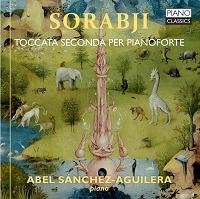Toccata Seconda per pianoforte
Abel Sánchez-Aguilera (piano)
Piano Classics: PCL10205 (March 2020)
Web page for Piano ClassicsWeb page for Piano Classics PCL10205
 Duration: 146:10
Duration: 146:10
Track listing
- Track 1-10: Toccata Seconda (145:52)
- Track 1: I. Preludio-Toccata (15:11)
- Track 2: II. Preludio-Corale (17:27)
- Track 3: III. Scherzo (10:26)
- Track 4: IV. Aria (11:36)
- Track 5: V. Ostinato (21:50)
- Track 6: VI. Notturno (14:18)
- Track 7: VII. Interludio – Moto perpetuo (8:03)
- Track 8: VIII. Cadenza – Punta d’organo (4:23)
- Track 9: IX. Fuga libera a cinque voci (32:28)
- Track 10: IX. Coda-Stretta (10:10)
Reviews
- “The Second Toccata (of four multi-movement works to which Sorabji gave this title), was composed in 1933-34, in the midst of one of the most fertile decades of Sorabji’s life which produced a number of major works of his early maturity as composer. The model for this Sorabjian genre was clearly Busoni’s Toccata (Prelude, Fantasia, Chaconne), as that for Opus clavicembalisticum was the Fantasia contrappuntistica, and in both composers’ cases their exploration and extension of Baroque forms derives from their veneration of Bach. Like the enormous Sequentia cyclica (02V012) the piece comprises multiple movements - nine in this case - that include a number of his favourite forms - chorale prelude, aria, ‘tropical’ nocturne, passacaglia, and a huge concluding fugue - though on a more modest scale of somewhat over two hours, similar to his Symphonia brevis (04M065), the shortest example of another highly characteristic multiple movement genre, with many movement types in common. The first movement is a fleet, rapid-running toccata-prelude which sweeps the listener into the action with exhilarating momentum. The following chorale prelude accumulates density and tension as it progresses, pauses and sets off again, inexorably rising to an apocalyptic climax. The waspish scherzo, in little irregular phrases and rhythmic groups, sounds like a translation of the caustic humour of Sorabji’s writings into music, by contrast with the beautiful polyphonic Aria that follows. The Ostinato, 49 (of course!) variations over a 14-note ground, is characteristically cumulative, like all Sorabji’s variation movements, though here the centrally placed climax of this arch-shaped movement acts as the fulcrum of the work as a whole. The viny entanglements of an extravagantly decorated tropical nocturne follow - this one reaching an unusually minatory climax - then two short movements that act as contrasting preludes to the final fugue, a scampering echo of the opening toccata and a monumental pedal-point portal to the last movement. This is a huge fugue, on one of Sorabji’s longest fugue subjects, thoroughly and meticulously worked out in ample episodes on the subject and the four countersubjects, crowned with a massive coda stretta.” (Records International)
- “Sorabji described this monstrous, two-hour-plus piece as “an admirable little work of 111 pages (!), one of the best things I’ve done so far,’ and he himself premiered it in Glasgow in 1936 under the auspices of the Active Society for the Propagation of Contemporary Music. It turned out to be his last public appearance as a pianist. The score, like so many of Sorabji’s works, was unpublished for decades. It was finally published in 2004 by the Sorabji Archive.
[...]
May he make further recordings, preferably of modern music such as this, for years to come!” (Art Music Lounge)
